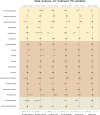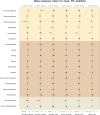This is a preprint.
Comparative Safety of Second-Line Antihyperglycemic Agents in Older Adults with Type 2 Diabetes: A Multinational Real-World Evidence From LEGEND-T2DM
- PMID: 40385382
- PMCID: PMC12083636
- DOI: 10.1101/2025.05.08.25327248
Comparative Safety of Second-Line Antihyperglycemic Agents in Older Adults with Type 2 Diabetes: A Multinational Real-World Evidence From LEGEND-T2DM
Abstract
Background: As prescribing of newer antihyperglycemic agents expands, there remains limited comparative safety data for older adults-a population particularly vulnerable to adverse drug events and underrepresented in clinical trials. We aimed to evaluate the real-world safety of second-line antihyperglycemic agents among older adults with type 2 diabetes.
Methods: We conducted a multinational cohort study using nine harmonized electronic health record and claims databases from the U.S. and Europe, applying a consistent analytical framework based on the LEGEND-T2DM initiative. Among adults aged ≥65 years who initiated a second-line agent after metformin monotherapy, we compared safety outcomes across four drug classes: GLP-1 receptor agonists (GLP1RAs), SGLT2 inhibitors (SGLT2Is), DPP-4 inhibitors (DPP4Is), and sulfonylureas (SUs). We used propensity score adjustment, empirical calibration, and prespecified diagnostics to estimate hazard ratios (HRs) for 18 safety outcomes.
Results: In a cohort of 1.8 million older adults, both GLP1RAs and SGLT2Is were linked to significantly lower risks of hypoglycemia (HR 0.21 [95% CI, 0.16-0.27] for GLP1RA vs SU; HR 0.21 [0.13-0.33] for SGLT2I vs SU) and hyperkalemia (HR 0.63 [0.50-0.81] for GLP1RA vs SU; HR 0.75 [0.63-0.90] for SGLT2I vs SU) and peripheral edema (HR 0.81 [0.71-0.92] for GLP1RAs vs. DPP4Is; HR 0.62 [0.46-0.84] for SGLT2Is vs. SU). However, SGLT2Is were associated with a higher risk of diabetic ketoacidosis compared to both GLP1RAs (HR 2.03 [1.38-2.99]) and SUs (HR 1.64 [1.27-2.11]). GLP1RAs had significantly higher risks of nausea (HR 0.63 [0.55-0.72]) and vomiting (HR 0.63 [0.57-0.69]) relative to SGLT2Is. Results were consistent across both on-treatment and intent-to-treat sensitivity analyses.
Conclusion: In older adults with type 2 diabetes, GLP1RAs and SGLT2Is demonstrated more favorable safety profiles than SUs and DPP4Is across multiple clinically relevant outcomes. These results support more informed, safety-conscious prescribing in a population underrepresented in clinical trials yet highly susceptible to adverse effects.
Figures



References
Publication types
Grants and funding
LinkOut - more resources
Full Text Sources
Research Materials
Miscellaneous
